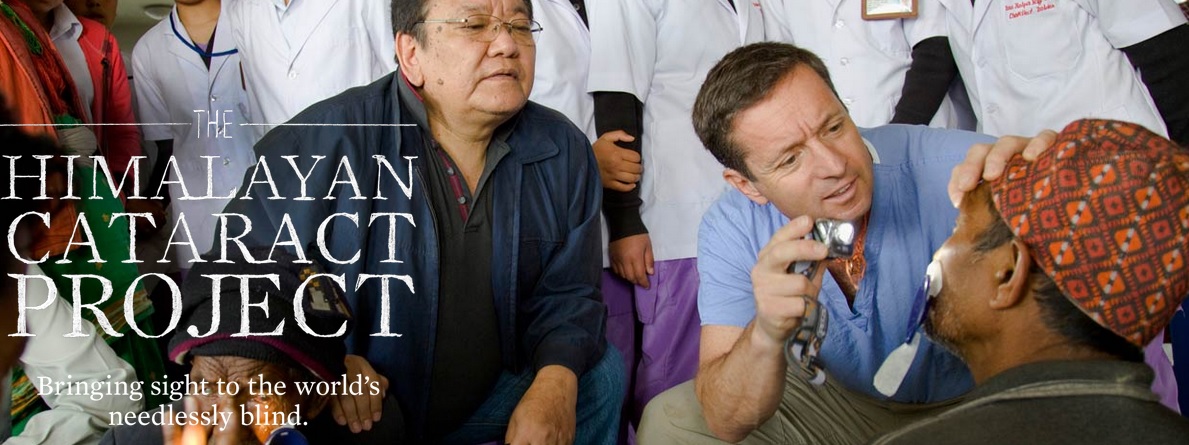
Over the last three decades Dr. Sanduk Ruit, a 61-year-old Nepali ophthalmologist, has successfully treated over 100,000 people across Asia and Africa through a simple suture-less cataract microsurgery technique that costs only $25 per patient. In mere 5 minutes, Dr. Ruit can make a small incision in his patient’s eye, remove the cloudy cataract impairing her vision, replace it with a low-cost intraocular lens, and change someone’s life forever. He has taught his “Nepal method”, which is now being studied in United States medical schools, to countless other eye surgeons in parts of the world as isolated as North Korea.
His sister’s death of tuberculosis, a preventable and treatable disease, motivated Ruit, then 17, to become a doctor. In 1981, Ruit completed a three-year ophthalmology residency at the All India Institute of Medical Sciences in Delhi, India and returned to Nepal. While working on the Nepal Blindness Survey, he met Fred Hollows, an Australian ophthalmologist. The duo decided to eradicate avoidable blindness among the world’s poorest people with limited access to public health services, who, they thought, deserved safe, affordable and high-quality eye care.
In 1986, Dr. Ruit studied with Hollows for 14 months at Sydney’s Prince of Wales Hospital in Australia. In 1988, Dr. Ruit, Fred and Gabi Hollows, and their team started the Nepal Eye Program Australia (NEPA) – which joined The Fred Hollows Foundation fold when it was founded in 1992. In 1994, when Dr. Ruit returned to Nepal, fundraising from NEPA and The Fred Hollows Foundation helped establish the Tilganga Eye Centre – an eye hospital in Kathmandu dedicated to providing world-class eye care to the people of Nepal.
Today, the Tilganga Eye Centre or Tilganga Institute of Ophthalmology includes hospitals, outreach clinics and training programs and an eye bank – using fees from better-off patients the centre is supporting the impoverished ones, conducting eye surgery on 30,000 patients annually. It also manufactures 450,000 tiny lenses a year for use in cataract surgery, keeping costs to $3 a lens compared to $200 in the West; the state-of-the-art lenses are also exported to nearly 50 countries around the world.
For those who lose an eye, Tilganga makes realistic-looking prosthetics that cost $3, compared to $150 for an imported false eye. For those unable to reach the center, or who live in otherwise isolated rural areas, Dr. Ruit and his team set up mobile eye camps, often utilizing tents, classrooms, and even animal stables to serve as makeshift operating rooms.
“We are all born with mission and it’s a very special thing. I’m at a stage where I’ve realized that my mission is to learn how best I can restore the sight for others, and how I can help others to do that multiply that effect with training. I’m trying to set up other centers around the world,” he says.
At first, skeptics mocked his innovations. But in June 2006, when Dr. Ruit was awarded with the Ramon Magsaysay Award, the West started noticing him. In January 2007, when the American Journal of Ophthalmology published a study of a randomized trial finding that Dr. Ruit’s technique had exactly the same outcome (98 percent success at a six-month follow-up) as the Western machines but at a faster and cheaper rate, he was finally taken seriously.
In May 2007, Dr. Ruit was appointed an Honorary Officer of the Order of Australia, “for service to humanity by establishing eye care services in Nepal and surrounding countries, and for his work in teaching and training surgeons, and technical innovation”.
According to the World Health Organization, an estimated 39 million people are blind worldwide. Of these, around 90% live in low-income areas and 80% suffer from conditions that can be prevented or cured. For some of these unfortunate people, Dr. Ruit has proved to be the God of Sight.
Dr. Sanduk Ruit along with Dr. Geoffrey Tabin also founded the Himalayan Cataract Project in 1995 to eradicate unnecessary blindness in the mountainous Himalayas. It has since spread far beyond the Himalayas – the HCP now funds and facilitates education, training, and equipment for local eye-care professionals across Asia and Sub-Saharan Africa. Together with its partners, the HCP has screened and examined over 5.2 million patients from 16 countries and has overseen around 500,000 low-cost, high-quality cataract surgeries.
“Dr. Ruit was the first doctor to put lenses in poor persons in the developing world. Nobody has restored sight to as many people,” Dr. Tabin told The New York Times.
When asked what it feels like to watch as a patient sees the world clearly the first time, he told CNN, “It really recharges you and makes you move forward.”
This Article (Meet The Doctor Who Cures Blindness In 5 Minutes) is free and open source. You have permission to republish this article under a Creative Commons license with attribution to the author and AnonHQ.com.






How do I get in contact with the doctor who cures the blind
Here you go Gretta: http://www.cureblindness.org/